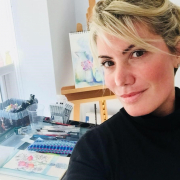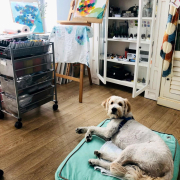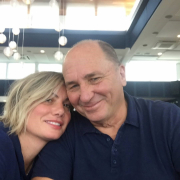By Denise Portner
 |
Lisa Katharina’s vibrant watercolors, still lives, and abstracts in shades of purple, pink, chartreuse, blue and yellow offer no hint of her daily struggles with the traumatic brain injury (TBI) she suffered in September 2014. The whimsical patterns and life-affirming energy give no suggestion of the frontal lobe deficits that limit her executive functioning or the neuro fatigue that forces her to take meditation breaks to recharge the “battery life” of her brain.
Thankfully, when Katharina, 49, is painting in her Philadelphia studio, her mind is at ease and she inhabits a comfort zone, able to create works that delight family, friends, and clients.
“This injury has had a life-changing impact on my day-to-day living, my social and professional life, my physical, emotional and mental health,” she says. “I have not had a normal day since the injury.”
With the help of her research neurologist, Mijail Serruya, MD, PhD, Assistant Professor in the Department of Neurology at Thomas Jefferson University, Katharina is developing tools to cope with her limitations, including good sleep hygiene, meditation breaks, and Harry, a service dog in training.
“I have not had a normal day since the injury.” |
My brain’s daily battery life depletes much faster than it used to,” Katharina says. “Understanding the 4 P’s of living with a brain injury was incredibly helpful to me at the beginning of my journey: Prioritizing, Planning, Pacing, and Positioning.
“Pacing myself over the course of the day is helpful,” she says. “My ability to accomplish everything I want to do in a day is limited by how much battery life my brain has when I wake up, and there is no scientific or accurate way to predict this.”
“I typically schedule priority activities in the morning, because a good night’s sleep allows your brain to recharge. I often bypass showering, doing laundry, or cleaning up in the morning because those activities play second fiddle to more important things such as meditation, vestibular and visual exercises, working on an art project or walking Harry and working with him on his training.”
Katharina paces herself by noting which activities might require more focus and effort, and planning pre-emptive meditation breaks to extend her mental energy. Having been a certified Kripalu Yoga instructor and Child Light Yoga instructor helped her in this. Katharina used to teach at several private schools and art museum school programs.
Kripalu Yoga instructor and Child Light Yoga instructor helped her in this. Katharina used to teach at several private schools and art museum school programs.
Katharina is also mindful of positioning herself in environments that are not visually overstimulating, such as busy grocery stores or crowded places where multiple conversations take place. Navigating the sensory environment has been a challenging adjustment.
“There is a component of grief that floats in and out of this new way of living,” she says. “Life goes on for those around me and I struggle with feeling left behind and isolated because I cannot participate in life the way I used to. I often struggle with memories of what I used to be capable of doing. It stings to have to repeatedly turn down invitations to things like a friend’s birthday party, a theatrical performance where a former student is the lead role, or an offer to drive down to the beach for a day.”
“I cannot stress enough the importance of finding a neurologist who participates actively in neurological research.” |
Katharina says she and Dr. Serruya are constantly searching for the treatment that is best suited to address the symptoms caused by damage to her oculomotor system, frontal lobes, temporal lobes and occipital lobes.
“Finding the most educated and supportive neurologist, who is willing to understand your problems, is crucial to healing,” she says. “When a therapy or a treatment work, I stick with it and keep practicing it, so I can participate in life. I cannot stress enough the importance of finding a neurologist who participates actively in neurological research, and a neuro-optometric doctor.”
Recently, Katharina acquired a loyal friend to help manage the activities of daily life.
“Harry, my service dog in training, has been an absolute gift and life saver for me mentally, emotionally and physically,” Katharina says. “He plays an important social role in my life by giving me the chance to safely enjoy the world. He naturally creates a barrier between me and people walking towards me on the street or in local shops, which is beneficial for my visual deficits. He serves as a visual aide to focus on while guiding me, whether it be around construction cones or towards openings at an intersection. Eventually, Harry will be able to guide me out of visually stressful situations that induce flooding -- a cognitive and sensory overload that many people with TBI experience.”
As the wife of a prominent local chef and restauranteur, Katharina also receives support – and great meals – from her husband, but acknowledges that it’s frustrating that they can’t take bike rides or do other things together that they used to do.
“TBI impacts everything and everyone in your life,” Katharina says. Living with a TBI means living with an invisible, chronic illness. It disrupts your finances, your professional life, your social life, and recovery can take years. People with brain injuries are six times more likely to commit suicide. If someone you know has a TBI, you have to work to understand their reality and support them for the long haul. Caregivers need to develop a support plan of their own when someone they love is impacted.”
“Creating artwork for others has given me a way to contribute to the world in a way that accommodates my new brain.” |
Providers should treat patients holistically, she says. Ideally, providers would be connected in comprehensive centers, where people living with TBI and their loved ones would receive individualized treatment and support plans, for the duration of their lifetime if necessary.
Katharina is an advocate for increased funding for educational outreach as well as neurological research and training. “We have yet to discover affordable and accurate diagnostic testing and treatments for the complex, expansive range of brain injuries,” she says. “We need financial support for alternative therapies, clinical trials and the development of comprehensive healing centers.”
She finds support online through NORA, the Neuro-Optometric Rehabilitation Association; Brainline; and the Centre for NeuroSkills.
“For me, supportive partners on this journey are those who make an effort to learn about my brain injury. They want to understand what accommodations are helpful for me, and then make an effort to remember practicing them,” Katharina says.
Helping a person with TBI live life to their fullest potential is also a gift one can give to a person with a TBI. Katharina’s prints, home décor and accessories are life-affirming for the both the artist and the recipients.
“Lisa's artwork is so playful and full of joy,” says one online customer. “I recently purchased the sunflower print. It brightens my house and makes me feel lighter every time I see it!”
Says another review: “[Lisa is] a creator of vibrant and playful beauty who gives us the kind of art that summons feelings of peace, joy, and hope.”
“I love when people ask me to create artwork for them, as it is something I can do on my own, that allows me to participate in life and make some else happy,” Katharina says.
“Whether it’s a creating a design for a card, a painting or an illustration, creating artwork for others has given me a way to contribute to the world in a way that accommodates my new brain.”
For examples of Lisa Katharina’s work, please visit her website at https://lisakatharina.com. A portion of the proceeds of Lisa Katharina’s sales benefit neurological research and education at Jefferson Health.
 |
 |
 |
 |
 |
 |
 |
 |
 |
